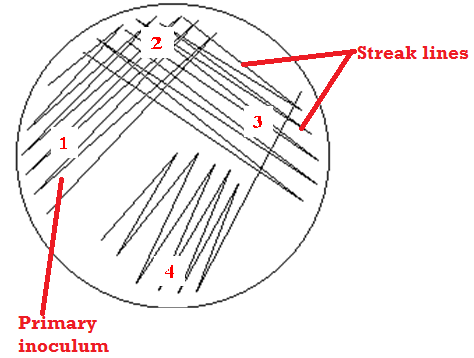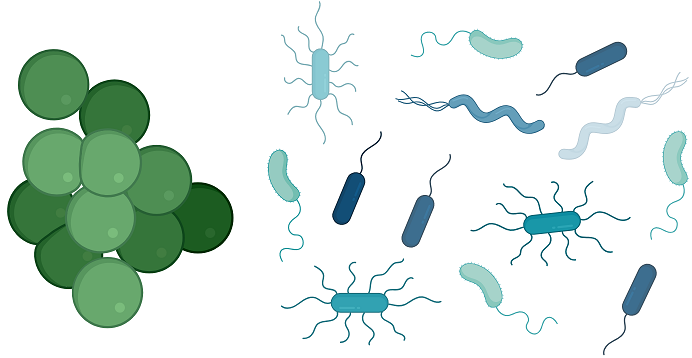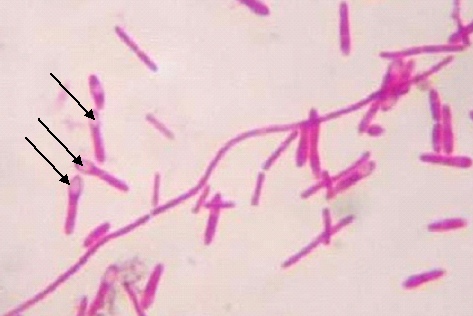Streaking is a microbiological technique that is used to obtain pure cultures of microorganisms (particularly bacteria) in the laboratory. It usually involves a series of drawing a loop (carrying an inoculum of the test organism or sample) back and forth on dried solid culture media.
As the streaking of the microbe on the dried solid culture media continues, the inoculum is thinned out along the streak lines as it is distributed along the culture media (Figure 1). By streaking or spreading the inoculum on the surface of a dried solid culture medium, single colonies of the inoculum will be obtained at some parts of the culture media plate during incubation.
Streaking is just one method of obtaining pure isolated colonies of bacteria. Other methods of obtaining pure cultures in the microbiology laboratory are the spread plate and pour plate methods.
In spread plate method, the test organism or sample is serially diluted in broth culture media before they are transferred onto dried solid culture media and then spread using the inoculating loop.
Pour plate methods involve serially diluting the test organism or sample in liquid culture media and then transferring same into molten agar. The molten agar containing the diluted inoculum or sample is then poured onto sterile Petri dishes and allowed to set or gel.
Streak plating, spread plating and pour plating are the three known methods used to obtain pure cultures in the microbiology laboratory.

Streaking is usually started at a point known as the primary inoculum on the solid media from where further streaks are made. As the streaking continues, the number of microorganisms on the loop reduces, and this ensures that a pure culture of the organism is obtained after the entire streaking process and incubation of the agar plate.
As shown in Figure 1, 1= flame the inoculating loop over a Bunsen burner flame, and streak a loopful of the broth, sample or test organism at point 1 as shown in the figure; 2= re-flamethe inoculating loop and allow it to cool, then streak the organism or specimen from point 1 to spread the original inoculum over more of the agar surface; 3= re-flame the loop again and continue the streak to point 3; 4= re-flame the inoculating loop again and allow to cool before streaking the inoculum from point 3 to point 4. Finally, label the culture plate and incubate it at the appropriate temperature condition while making sure that the Petri dish plate is inverted.
REFERENCES
Atlas R.M (2010). Handbook of Microbiological Media. Fourth edition. American Society of Microbiology Press, USA.
Balows A, Hausler W, Herrmann K.L, Isenberg H.D and Shadomy H.J (1991). Manual of clinical microbiology. 5th ed. American Society of Microbiology Press, USA.
Basic laboratory procedures in clinical bacteriology. World Health Organization (WHO), 1991. Available from WHO publications, 1211 Geneva, 27-Switzerland.
Black, J.G. (2008). Microbiology: Principles and Explorations (7th ed.). Hoboken, NJ: J. Wiley & Sons.
Garcia L.S (2010). Clinical Microbiology Procedures Handbook. Third edition. American Society of Microbiology Press, USA.
Garcia L.S (2014). Clinical Laboratory Management. First edition. American Society of Microbiology Press, USA.
Ira R (1995). Bacteriology, Standard Operative procedure manual for microbiology laboratories, National Institute of Biologicals. Pp. 73-97.
Madigan M.T., Martinko J.M., Dunlap P.V and Clark D.P (2009). Brock Biology of Microorganisms, 12th edition. Pearson Benjamin Cummings Inc, USA.
Woods GL and Washington JA (1995). The Clinician and the Microbiology Laboratory. Mandell GL, Bennett JE, Dolin R (eds): Principles and Practice of Infectious Diseases. 4th ed. Churchill Livingstone, New York.
Discover more from Microbiology Class
Subscribe to get the latest posts sent to your email.




